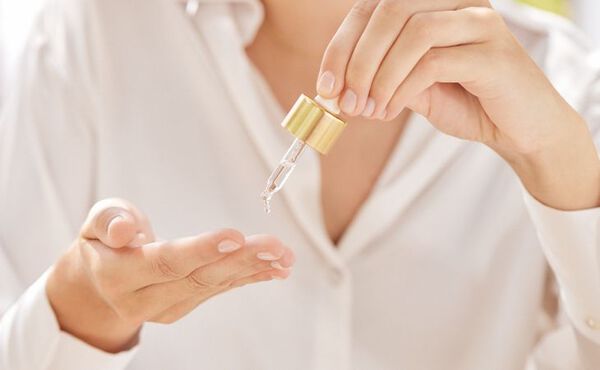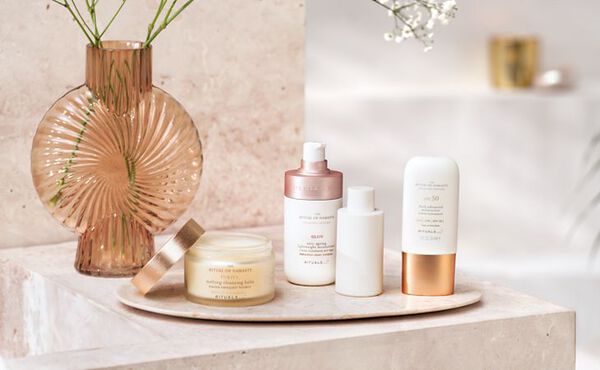Discover essential steps for a skincare routine that promotes glowing, healthy skin. Transform your complexion with our in-depth expert guide.
The perfect skincare routine does exist, you just need to understand your skin type and what it needs. Here we reveal how to build a skincare routine for your complexion and how to layer those products for the best skin-glowing results.
The beauty industry is a booming business, and that can make it difficult to choose which products are necessary and which are simply nice to have. In what order should you apply all those creams and serums? What should you pay attention to when buying new skincare products? Which ingredients are important and how do you know which products best suit your skin? These guidelines for the ideal skincare routine are your short cut to a radiant complexion.
We really do get it. Some nights you’re just too tired and some mornings you’re just too busy to spend more than 5 minutes on caring for your skin. However, investing more time in your routine is truly worth it, because our skin goes through a lot on a daily basis. For example, it’s very important to protect your skin against air pollution and UV-rays. Your complexion needs hydration, some help removing dead cells and a boost when it comes to anti-ageing. The secret to a happy, healthy complexion is building a skincare routine that is simple, effective and can easily be tweaked.

Starting point: Deciphering Your Skin Type for Your Skincare Routine
The thing is, while we’re all born with a skin type determined by genetics, it can be affected by different factors like stress, lifestyle and hormones. “There are four primary skin types: normal, lipid dry, oily, and combination,” says Ksenia Selivanova, skin expert. Anything beyond normal, lipid dry, oily and combination is known as secondary skin concerns. These are any skin concerns such as sensitivity, dehydration, ageing, acne and rosacea. Incorporating appropriate acne treatments into your skincare routine can help manage and treat acne breakouts effectively.
How do you know what your skin type is? The best way to check fast is to wash your face, gently towel dry and leave it for 20 minutes without applying any skincare. Once the 20 minutes is up, how does it feel?
If it feels okay, then your skin is normal. If it has a tight feeling all over then you likely have dry skin. Got a slick of oil, then it’s oily. Whereas if the oil is just in your T-Zone (forehead, nose, chin) and your cheeks feel tight then you likely have combination skin.
Understanding Your Skin Type
are five main skin types: normal, oily, dry, combination, and sensitive. Normal skin is balanced and has a smooth texture, while oily skin tends to be shiny and prone to blackheads. Dry skin is tight and flaky, and combination skin is a mix of oily and dry skin. Sensitive skin is easily irritated and may react to certain products.
To determine your skin type, wash your face with a gentle cleanser and wait for about 30 minutes without applying any products. Observe your skin’s texture and appearance. If it looks shiny, you may have oily skin. If it feels tight and flaky, you may have dry skin. If it’s a mix of both, you may have combination skin. If you experience redness or irritation, you may have sensitive skin.
Normal Skin
When you have normal skin, your pores are small, and you don’t experience things like rashes, breakouts, or dry or oily patches. Lucky you!
Dry Skin
If your skin feels tight and you sometimes suffer from flakiness or dullness, you have lipid dry skin where the skin barrier is compromised meaning you easily lose moisture. In this case, you could be dealing with skin texture that feels textured and isn't plump or glowy.
How do you know if your ski is dry or dehydrated? Dry skin tends to come with redness and flaky texture, where as dull skin will look dull and lacklustre.
Oily Skin
With oily skin, you can experience excess oil, blackheads, blemishes and your pores are larger and therefore more visible; acne-prone skin is common with this type.
Combination Skin
Finally, combination skin means your T-zone (forehead, nose and chin) is oilier than the rest of your face. Your cheeks could be normal or even dry.
Then, of course, as we get older, whatever our skin type, you can start to look to an anti aging skincare routine to tackle fine lines and less plump skin caused by the reduction in the production of collagen and elastin that keeps skin youthful and bouncy.
Identifying Skin Concerns
Identifying your skin concerns is essential in creating a targeted skincare routine. Common skin concerns include acne, hyperpigmentation, fine lines, and dryness. Acne-prone skin is characterized by frequent breakouts and blackheads.
Hyperpigmentation is the appearance of dark spots or discoloration. Fine lines and wrinkles are signs of aging skin. Dry skin is characterized by tightness and flakiness.
To identify your skin concerns, examine your skin closely. Look for areas of redness, inflammation, or discoloration. Take note of any breakouts or blackheads. Observe the texture of your skin, whether it’s smooth or rough. By identifying your skin concerns, you can create a skincare routine that addresses your specific needs.
Keep it simple
You don’t need to adopt a complex 12-step Korean-inspired routine to have great skin, but you do need to be a little strategic with your daily skincare routine depending on how your complexion is behaving. Take a moment to think about what your primary skin type is and what your secondary concerns could be—use those as your compass to finding the products you need. And remember, “your morning skincare routine should focus on protection, while your night-time goal is to nourish and stimulate your skin,” says Megan Felton, skin expert.
The daily skin care routine for you
An essential routine will vary slightly depending on skin type and concern, but it should basically consist of 3 steps; cleansing morning and night, a treatment product such as a booster, serum or toner, which could be used morning and/or night, plus a moisturiser. The more advanced skincare routine takes longer, infusing your skin with a little more (targeted) care.
An essential morning and nighttime routine would consist of the following:
Morning & evening skin care routine
- Cleanse - this will refresh skin and remove any dirt or makeup.
- Serum - your chosen serum is ideal for targeting those skin concerns.
- Moisturiser - to keep skin hydrated and happy.
A comprehensive routine might be something like this:
Morning routine
- Cleanser
- Toner
- Booster
- Serum
- Eye cream
- Day cream
- SPF
Nighttime routine
- Double cleanse (you can read all about the benefits of cleansing twice here).
- Exfoliator
- Toner
- Booster
- Serum
- Night cream and/or oil
Now, let’s look at each step in more detail:

Cleansing
Cleansing is one of the most important steps in your skincare routine especially if you wear makeup. Your skin comes in contact with air pollution and other contaminants on a daily basis, and these things need to be removed at night so a nighttime cleansing routine is paramount. It’s also important to cleanse your skin again in the morning to prevent clogged pores. How you do this is dependent on your skin type and personal preference.

Cleansing dry or sensitive skin
Dry or sensitive skin will want a nourishing milk cleanser or an oil based cleanser, just avoid essential oils if you have particularly sensitive skin.
Cleansing oily or acne prone skin
Oily skin, acne prone skin or combination complexions can use foaming cleansers or even an oil cleanser, as they breakdown sebum nicely, double cleansing at night will ensure pores don’t become clogged. Micellar water, on the other hand, is suitable for all skin types and is a good choice for mornings.
Toning
Toners are used after cleansing using a cotton pad. A thin fluid, these are designed to remove any stubborn impurities deliver added nutrients, balance out your complexion and help the subsequent products in your regimen absorb better. A great choice for all skin types, alcohol-free toners will soothe and hydrate dry skin balancing the pH levels, while removing excess oil from oily/combination complexions.
Boosters
As you might have guessed, our boosters are designed to give your skin a boost! Each contains a specific mix of ingredients and can be applied to the skin in just a few seconds. Each booster has one active ingredient in a higher concentration, to cater to your specific skin need and skin type. These can help to rehydrate, re-plump, and revitalise on a deeper level. Because toners and boosters are lighter than serums, these should be applied first. You don’t need to use them all the time, but you can add them to your routine as and when your skin needs a little extra assistance.

Boosters we recommend
We love the bakuchiol booster, nature's alternative to retinol that helps to stimulate cell turnover to reduce fine lines. A few drops of our Cica booster will aid skin repair, while our antioxidant-rich Vitamin C serum helps prevent skin damage from free radicals and pollution.
Serums
Thinner than day or night creams, serums usually contain a higher concentration of active ingredients. The lighter texture means they absorb deeper into the skin so they can get to work where they can make the most difference. They're typically applied before moisturisers and are suitable for pretty much all skin types.

Eye creams
Whether your eye cream is serum-like in texture or richer, it’s best to apply with your ring finger before your oil/moisturiser. Because the skin around the eyes is more sensitive it requires specialised care, like a more tolerable concentration of active ingredients. If your main concerns for the under-eye area are lines, puffiness, hyperpigmentation or dark circles, there are plenty of eye creams out there that’ll run to your aid.
“If you are prone to puffy eyes, I would advise you to only apply eye cream in the morning,” says international skincare expert Abigail James. “The skin around the eyes is finer, and products can sit in this delicate area while you’re sleeping and circulation has slowed.”
Serums to try
Our anti aging serum contains Backuchiol Repair Complex, perfect if you're looking for antioxidant serums to protect and support the skin throughout the day. Incorporating an antioxidant serum in your morning routine can brighten and protect your skin from environmental damage. With hydrating ingredients our hydrating serum contains a Hyaluronic Activator Complex. The hyaluronic acid is like a glass of water for the skin - ideal for dry or dehydrated complexions, as well as spot-prone complexions that can't handle anything too rich.
Day and night creams
Apply a day cream in the morning and a night cream in the evening. Night creams can help improve skin tone while moisturizing during the night. These are often designed to suit your specific skin type and are meant to hydrate your skin, lock in moisture and leave your complexion smoother and softer.
A good rule of thumb is that if you have oily skin then you should use an oil free moisturiser to prevent clogging pores, whereas rich moisturizers are ideal for very dry skin.
Face oils
Face oils nourish the skin and lock in any active ingredients, so which you choose comes down to personal preference. If your skin is particularly dry you may wish to use both oil and moisturiser, whereas oily and blemish-prone skin types might want to skip the oil. A water-based moisturiser can’t permeate oil, so to be on the safe side always pat your oil onto dry patches after you’ve applied your cream (if you’re using one). Otherwise, treat your skin to a massage with the oil if you’re using it alone.

SPF
Even in winter, using SPF daily helps reduce the risk of skin cancer by protecting your skin from UV rays. Although a lot of creams contain an SPF, it’s actually much better to use sun protection on top of your day cream. Sun damage can show up on the skin as pigmentation, texture changes, and fine lines.

Massage your skin
“Once a week, I love doing a face massage with an oil. This not only nourishes the skin with essential fatty acids and oils, it also boosts circulation, relaxes muscles and provides an essential moment of selfcare,” says Abigail.
Masks and exfoliators
With face masks and exfoliators aim to include these in your routine a couple of times a week. If you exfoliate before, you’ll be supercharging the effects of your face mask.
“A mask, once a week in the evening, is a great way of giving the skin a boost. If you’re more prone to oily skin, you might choose a charcoal mask. If you need hydration and vibrancy, the AHA mask or hydrating sheet mask is perfect,” notes Abigail.

On nights where you use a mask, you can skip the booster, serum and perhaps the night cream and/or oil depending on your skin type and the mask you used. For instance, if the mask was incredibly nourishing you may not need an extra layer of moisture, but if you used an AHA mask a moisturiser will finish off your at-home treatment nicely.
An exfoliator is a mild facial scrub that remove dead skin cells, unclog pores and brighten skin. A good exfoliator also contains alpha hydroxy acids such as glycolic acid or lactic acid to loosen dead skin cells and encourage cell turnover. The beta hydroxy - salicylic acid to unclog pores, which results in a fresher and more radiant complexion so it's a good ingredient to look out for if you deal with acne breakouts.
With age and other factors like sun damage, your skin has more difficulty removing the dead cells, making exfoliation necessary. Your skin needs to adjust to this, so start off slowly. The general rule is 1-2 times a week; if you do this, you’ll notice that it’s a bit of a miracle cure for blemishes, wrinkles and dry skin. When you use an exfoliator on a regular basis, it’s extra important that you keep the skin hydrated afterwards.
How to layer
“A good way to remember how to layer your products is to start with the thinner, water-based, products first like your toner and booster followed by oil-based, thicker products. You should always end with your SPF in the mornings,” says Megan.
Skincare expert Abigail James notes that "any oil on the skin will slow down the penetration of the actives in water type products. So, once the skin has been cleansed, apply a toner or booster. If you are going to apply a serum, I would do this after a booster, and then apply a moisturiser after the serum. If you are particularly dry, it’s also lovely to add a drop of face oil to your cream."
The ingredient list
No matter what products you use during your skincare routine, always check the list of ingredients to limit the chance of something that will irritate your skin. Don’t be intimidated by difficult terminology; research which ingredients are best for your skin type and be well-informed. Avoid products that contain alcohol and make sure that perfume is the last ingredient on the list, because this means the product doesn’t contain a lot of it. Ingredients that have been scientifically proven to be good for your skin include retinol, vitamin E and vitamin C. There are also ingredients that you should generally avoid, like parabens, mineral oil and silicon.
Discover our glossary of skincare ingredients that will make your complexion glow.

Tackling breakouts
Got acne prone skin? "If you have a sudden breakout, a key change to your routine should be to reduce the level of cream moisturiser," notes skincare expert Abigail James. "Switch to a gentle wash cleanser and add a charcoal mask twice a week along with a more regular exfoliation."
Adjusting your skincare routine with age
As our skin ages, we do need to consider changing our skincare routine, since our hormones and lifestyle can be quite different in our 20s compared to when we’re in our 40s.
Generally, a younger skin would benefit from lighter textured creams and serums. Anything too heavy or nourishing might create breakouts, so don't jump to “anti-ageing products” too soon!
From 40 onwards, our hormones—especially estrogen—are on the decline, which causes more dry skin conditions, increases the need for more hydration and makes the layering of products essential. Added hydration doesn't just come in the form of heavier creams—it can also come in the form of hydrating actives such as hyaluronic found in serums and ampoule boosters. Applying a lovely moisturiser after this will help seal in the extra hydration.
Our natural skin cell turnover also drops dramatically as we get older, so exfoliation to encourage this process helps keep the skin looking and feeling youthful. An exfoliated skin also reflects the light more effectively, giving a dewier appearance. In addition, exfoliation allows our other skincare ingredients to absorb more effectively. As we are removing the dead skin cells from the skin’s surface, we are clearing the path for our skincare routine to work even better.
Finding your perfect skincare routine can involve some trial and error. “If you have a sudden breakout, a key change to your routine should be to reduce the level of cream moisturiser,” says Abigail. “Switch to a gentle wash cleanser and add a charcoal mask twice a week along with a more regular exfoliation.”
Anti-Aging and Skin Health
Anti-aging and skin health are important considerations in creating a skincare routine. As we age, our skin loses collagen and elastin, leading to fine lines and wrinkles. To combat this, look for products that contain retinol, vitamin C, or peptides. These ingredients help stimulate collagen production and improve skin texture.
In addition to anti-aging products, maintaining good skin health is essential. This includes protecting your skin from the sun by using a broad-spectrum sunscreen with at least SPF 30. It also includes getting enough sleep, staying hydrated, and eating a balanced diet rich in fruits and vegetables.
Choosing the Right Products
Choosing the right products for your skin type and concerns is crucial in creating an effective skincare routine. Look for products that are labeled “non-comedogenic” or “oil-free” if you have oily skin. If you have dry skin, look for products that are rich in emollients and humectants. If you have sensitive skin, look for products that are fragrance-free and hypoallergenic.
When choosing products, read the ingredient label carefully. Look for ingredients that address your specific skin concerns. For example, if you have acne-prone skin, look for products that contain salicylic acid or benzoyl peroxide. If you have dry skin, look for products that contain hyaluronic acid or ceramides.
Customizing Your Routine
Customizing your skincare routine is essential in addressing your specific skin concerns and needs. Start by identifying your skin type and concerns. Then, choose products that address those concerns. Be sure to read the ingredient label carefully and look for products that are labeled “non-comedogenic” or “oil-free” if you have oily skin.
In addition to choosing the right products, customizing your routine also involves creating a consistent skincare schedule. This includes washing your face twice a day, once in the morning and once at night. It also includes applying a toner, serum, and moisturizer in the right order. By customizing your routine, you can create a skincare routine that addresses your specific needs and concerns.
-
Promotions
14,90 € 19,90 €Incl. Taxes20 ml (745,00 € / 1 l)View full detailsIncl. Taxes20 ml (745,00 € / 1 l) -
14,90 €Incl. Taxes150 ml (99,33 € / 1 l)View full detailsIncl. Taxes150 ml (99,33 € / 1 l)
-
34,90 €Incl. Taxes50 ml (698,00 € / 1 l)View full detailsIncl. Taxes50 ml (698,00 € / 1 l)
-
34,90 €Incl. Taxes50 ml (698,00 € / 1 l)View full detailsIncl. Taxes50 ml (698,00 € / 1 l)






.jpg?sw=600&sh=370&sm=fit&cx=0&cy=0&cw=600&ch=370&sfrm=jpg)



